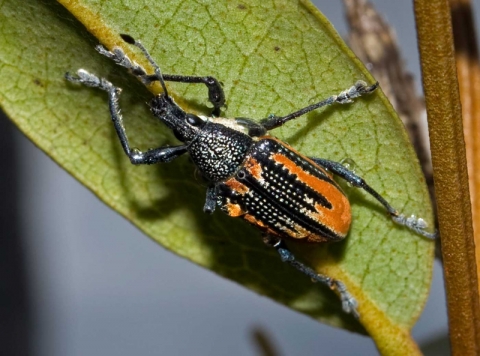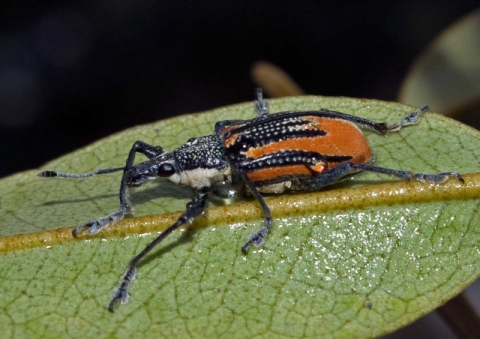Some of the most interesting-looking creatures in the insect world (and among the most destructive to crops and ornamental plants) are the weevils, family Curculionidae. Their larvae feed on the roots of plants while their adult forms munch on the leaves, forming a one-two punch that can cause enormous damage. These phytophagorous habits, combined with their astonishing (albeit typical for insects) fecundity, can lead to important economic consequences for those whose livelihoods depend on selling fruit crops. For those of us who are just interested in what’s in our gardens, the consequences are usually somewhat less disastrous.
Case in point: Diaprepes abbreviatus (Linnaeus). I found an adult on my Jamaican caper (Capparis cynophallophora) the other day:
One bug, on one plant. And no other signs of infestation.
For now, I’m content to see how the garden ecology reacts to this potential pest species. If the wasps don’t get them, perhaps the White Ibis pair I saw this morning digging into the soil in my front yard will. If those don’t get them, perhaps the infestation won’t be too severe. If they rise to the level of pest in my garden, I’ll figure out what to do then. For now, I’m just celebrating the arrival of another new (to me) bug!
It’s quite a striking little weevil, with its broad head (one of its higher level taxonomic groupings is called Entiminae, “broad-nosed” or “broad-snouted” weevils), its bright red background color with prominent black marks (could we call this the Stendhal bug?), and its apparent docility (it stood quite still while I snapped my photos; one of the hallmarks of the adult weevil is that it will often “play dead” when discovered):
All in all, a relatively anodyne encounter with this fearsome pest.
Etymology: Linnaeus, the father of modern biological taxonomy, originally described this species in 1758 as Curculio abbreviatus. Curculio is Latin for weevil. Prepes is Latin for “flying quickly,” while the prefix dia- is Greek for “through, between.”
Not sure if that’s what Schoenherr, the creator of the new genus name, Diaprepes, was thinking about when he named the genus, which contains 16 species centered on the West Indies. According to O’Brien and Kovarik,
Diaprepes was first used in a list of genera by Schoenherr in 1823, who described the genus in 1826. Diaprepes abbreviatus was listed from the “Indiis” by Linnaeus without reference to the West Indies or East Indies. The original type specimen of D. abbreviatus is still in the museum in Lund, Sweden, where it was deposited more than two centuries ago.
It’s more likely that Schoenherr was thinking of the lost island civilization of Atlantis. As you can find out, through the magic of this world-wide information network, Diaprepes was the 10th son of Poseidon and ruler of the last of the 10 kingdoms of the lost island Atlantis; perhaps the origin of the genus in the West Indies suggested the name to the German scholar.
It’s been a week since I first saw this guy, and I’ve yet to see another, so I’m going to say that one man’s pest is another man’s opportunity. Cheers!
References
O’Brien, C.W. & P.W. Kovarik. (2000). The Genus Diaprepes: Its Origin and Geographical Distribution in the Caribbean Region.


